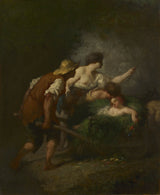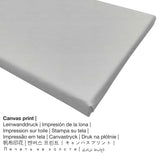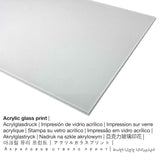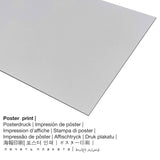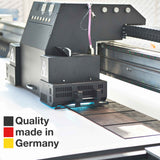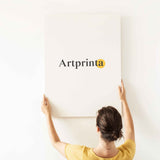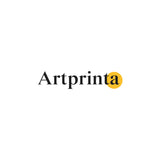Jean-François Millet, 1847 - Si n'Ubi lọta - ọmarịcha nka
Ụtụ gụnyere. Mbupu gbakọrọ na ndenye ọpụpụ.
Nhọrọ akụrụngwa ngwaahịa enwere ike
Ngwa ndetu ngwaahịa na-enye gị ohere ịhọrọ ihe na nha ọkacha mmasị gị. Anyị na-ahapụ gị ka ịhọrọ n'ime ụdị ndị a:
- Ihe odide acrylic glass: A glossy print on acrylic glass, often labelled as a plexiglass print, will change the artwork into amazing décor. Your artwork is printed thanks to state-of-the-art UV direct print machines. This has the impression of vibrant and impressive color tones.
- Mbipụta nke aluminom: An Aluminium Dibond print is a material with an outstanding depth effect - for a modern impression and a non-reflective surface. The Direct Print on Aluminum Dibond is your ideal introduction to fine art prints on aluminum. For the Aluminium Dibond print, we print the favorite artwork onto the aluminium composite surface. This direct print on Aluminum Dibond is one of the most demanded entry-level products and is a truly stylish way to display art reproductions, because it draws focus on the whole artwork.
- Mpempe akwụkwọ (ihe kwaaji): The poster is a printed flat cotton canvas paper with a slightly rough finish on the surface, which resembles the actual version of the work of art. The poster print is suited for putting your art replica with a custom frame. Please bear in mind, that depending on the absolute size of the poster print we add a white margin between 2-6cm round about the work of art in order to facilitate the framing with a custom frame.
- Kwaaji: The canvas direct print is a printed cotton canvas stretched on a wooden stretcher. A canvas has the plastic effect of three dimensionality. The great advantage of canvas prints is that they are relatively low in weight, which means that it is quite simple to hang the Canvas print without extra wall-mounts. That is why, canvas prints are suited for all types of walls.
Disclaimer: We try whatever we can in order to depict the art products as accurate as possible and to display them visually. Please bear in mind that the tone of the print products and the printing can vary marginally from the image on your device's screen. Depending on the settings of your screen and the condition of the surface, colors might not be printed 100% realistically. Because the art prints are processed and printed manually, there may also be slight discrepancies in the motif's exact position and the size.
What specifically does the The Cleveland Museum of Art state about the 19th century work of art from the painter Jean-François Millet? (© - by The Cleveland Museum of Art - www.clevelandart.org)
This idealized vision of noble peasant life was painted during a period of intense industrialization in France, accompanied by economic depression and the abandonment of farms. Nostalgic peasant scenes were especially popular in the 1840s, a stark contrast to the disillusionment and tension that would violently surface in the Revolution of 1848. The vague shapes and faces of the family seen here make them symbols of the land, rather than individuals.
Nkọwa ngwaahịa nka
Return from the Fields bụ site n'eziokwu French artist Jean Francois Millet. The painting has the size: Framed: 68 x 60 x 10 cm (26 3/4 x 23 5/8 x 3 15/16 in); Unframed: 46,2 x 37,8 cm (18 3/16 x 14 7/8 in). Mmanụ na akwa ákwà was used by the French painter as the medium of the piece of art. The original artpiece has the following inscription: "signed lower right: J. F. Millet". Nowadays, the work of art can be viewed in in the Ụlọ ihe ngosi nka nke Cleveland mkpokọta nka na Cleveland, Ohio, United States nke America. Site n'ikike nke Velọ ihe ngosi nka nke Cleveland (ikike ngalaba ọha). Ihe kredit nke ọrụ nka bụ: Maazị na Oriakụ William H. Marlatt Fund. What is more, the alignment is portrait with an image ratio of 1 : 1.2, meaning that ogologo bụ 20% mkpụmkpụ karịa obosara. The painter Jean-François Millet was a European artist, whose art style can be attributed mainly to Realism. The European painter lived for a total of 61 years - born in 1814 and passed away in 1875 in Barbizon.
Iberibe nkọwa nka
| Aha eserese: | "Return from the Fields" |
| Nhazi: | sere |
| Otu izugbe: | nkà nke oge a |
| Nhazi oge: | 19th narị afọ |
| Emepụtara na: | 1847 |
| Afọ nka: | karịa afọ 170 |
| Agba na: | mmanụ na akwa ákwà |
| Akụkụ izizi (ọrụ nka): | Nhazi: 68 x 60 x 10 cm (26 3/4 x 23 5/8 x 3 15/16 na); Edebereghị: 46,2 x 37,8 cm (18 3/16 x 14 7/8 na) |
| Akara aka na nka nka: | signed lower right: J. F. Millet |
| Ụlọ ihe ngosi nka: | Velọ ihe ngosi nka nke Cleveland |
| Ebe ngosi nka: | Cleveland, Ohio, United States nke America |
| Weebụsaịtị ihe ngosi nka: | www.clevelandart.org |
| Licensedị ikike: | ngalaba ọha |
| Site n'aka: | Velọ ihe ngosi nka nke Cleveland |
| Ebe kredit nke ọrụ nka: | Maazị na Oriakụ William H. Marlatt Fund |
Ngwaahịa a
| Bipụta ụdị ngwaahịa: | nka nka |
| Usoro mmeghari: | dijitalụ mmeputakwa |
| Usoro mmepụta: | UV kpọmkwem obibi |
| Mmalite ngwaahịa: | emepụtara na Germany |
| Stockdị ngwaahịa: | mmepụta ihe na-achọ |
| Eji ngwaahịa emebere: | nka mgbidi, gallery mgbidi |
| Ndozi onyonyo: | usoro eserese |
| Njikwa oyiyi: | 1: 1.2 - ( Ogologo: obosara) |
| Pụtara nke akụkụ akụkụ: | ogologo bụ 20% mkpụmkpụ karịa obosara |
| Nhọrọ ihe dị: | ígwè obibi akwụkwọ (aluminium dibond), akwụkwọ mmado (akwụkwọ kwaaji), mbipụta enyo acrylic (nke nwere ezigbo mkpuchi iko), mbipụta akwụkwọ. |
| Ọdịiche dị n'okirikiri akwa akwa akwa (akwa akwa): | 50x60cm - 20x24", 100x120cm - 39x47", 150x180cm - 59x71" |
| Mbipụta iko acrylic (nwere ezigbo mkpuchi iko) dị iche iche: | 50x60cm - 20x24", 100x120cm - 39x47", 150x180cm - 59x71" |
| Nhọrọ nke mbipụta akwụkwọ mmado (akwụkwọ kwaaji): | 50x60cm - 20x24", 100x120cm - 39x47" |
| Mbipụta nke aluminom (ihe aluminom): | 50x60cm - 20x24", 100x120cm - 39x47" |
| Igwe onyonyo: | na-enweghị etiti |
Onye na-ese ihe
| Aha onye nka: | Jean Francois Millet |
| okike onye nka: | nwoke |
| Obodo onye nka: | French |
| Ọrụ: | onye na-ese ihe |
| Mba onye si: | France |
| Nhazi nke onye nka: | omenkà nke oge a |
| Ụdị nka: | Ihe ngosi |
| Afọ ọnwụ: | 61 afọ |
| Afọ ọmụmụ: | 1814 |
| Nwuru: | 1875 |
| Ebe ọnwụ: | Barbizon |
Copyright right, www.artprinta.com (Artprinta)

